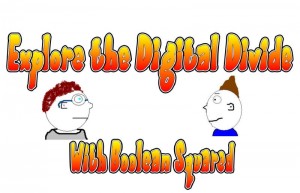I have long been a big fan of Edublogs for many reasons:
- it provided me with my first free blogging platform,
- the forums have been a great way to get help and resources,
- James Farmer, who runs the network, has been incredibly responsive to any of my queries,
- and the network of educators using blogs has continued to grow (the number hovers around 250,000 blogs on Edublogs).
Those facts continue to be the case, but I knew the idea of a cost-free, ad-free network could not last forever. After all, we can’t expect James to keep investing his own money just to keep our blogs alive and free. There was bound to be a time when change was to come.
So, the inevitable happened.
Edublogs is still “free” but now it comes with advertisements — keyword links in posts that bring the viewer to an advertisement. In the Edublog forums and through various networks, this has been met with a lot of criticism and complaints, and I can understand both sides of the issue here. Teachers don’t want to expose students to advertisements … period. I know I avoid it at all costs. Our kids are bombarded with commercial messages everywhere they go — embedded in movies, in games, on television, on the Net — and I don’t want to be part of that.
But James admits that he can’t afford to keep this blogging network afloat under the “free” model. It just doesn’t make sense. And he does offer a solution that costs a little bit of money.
First, the linked advertisements only show up the first time a person visits a blog. If you bookmark a blog, the second time you go there, the ads will not appear in your browser. This is designed to minimize the impact of the ads.
Second, if you become an Edublog Supporter (which I have been since it was first offered, as a token way to support the network), there are no ads in your blog at all, ever. The cost is $40 per year, up from the initial $25 per year. And, James has added the feature of allowing Supporters to create up to 30 blogs (say, for students) under one Supporter umbrella and you can turn off the ads on all of those blogs. (There is also the option of Edublog Campus, which allows you to create and run your own larger blogging network. We currently use this for our Western Massachusetts Writing Project).
James explains the moves in a recent post:
Is this ideal? Well, in a utopian world we’d like to give everyone, everything, entirely for free and without any ads! But that’d be a utopia… so, barring that, we hope to still provide great free blogs alongside an absolutely premium supporter service that is more than worth the price of a large coffee per month.
To coax people to become a Supporter, James has also curtailed some of the things he used to provide for free, including plug-ins, more upload space, Twitter tools, etc, and expanded them for Supporters.
Although I will continue with Edublogs, I think this change in the model for Edublogs will make me re-think how I do workshops with teachers who are trying to understand what blogging is all about. I have often used Edublog in sessions precisely because I could tell folks: this is free, this is ad-free, and it is simple to use. I can’t do that anymore, and that saddens me, to be honest. If you are a teacher looking to blog, you can become a Supporter with Edublogs, or you can explore other options, including running your own WordPress package on server space. But, truly, how many teachers have that time and expertise to set up and host their own blogging network? There is also Blogger, also with ads, and other possibilities, too — many with limitations and drawbacks.
I don’t plan to pack up and move from this place, and I will continue to run this blog, the Electronic Pencil and a homework site that my teaching team uses for parents and students to access information and assignments. I am a supporter, even though I wish that Edublogs had not had to turn the corner into advertising. Isn’t there someone with a boatload of cash who can support a network of teachers exploring the wired world? (if so, please leave name and number where you can be reached).
Peace (brought to you by the makers of dogtrax),
Kevin







